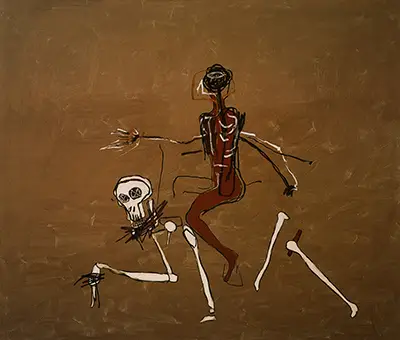The artist famously learned about art simply, "...by looking." He was not allowed into several art colleges and remained on the fringes of this profession until his hard work and perseverance ensured that he eventually achieved fame and artistic respect. It is a wonder as to how his style may have developed had he been taken into some of these academic courses, and perhaps his position on the fringes was a part of his success ultimately - ensuring his style and ideas were entirely his own and untouched by more traditional minds who were a part of what he considered the establishment. He remained very much his own man for his entire life, constantly appearing to court controversy, simply be being himself. He was vocal on political issues of the time and Riding with Death is another example of that. Sadly, many of these issues remain within his native US still today, though some progress has been made.
This painting features a brown background that appears to have been delivered at speed, with little interest in smoothing out the stroke marks that remain today. This blandness may remind some of the backgrounds used in some Joan Miro paintings, such as Snail, Woman, Flower, Star and Dog Barking at the Moon. Indeed, they both use the darkness and lack of detail to allow the next layer of content to dominate the focus, and Basquiat does the same too within Riding with Death. In the latter's case, he pictures a frenetic brown figure sat astride a skeleton, both loosely formed in his typical Neo-Expressionist style. It is immediately clear as being a play on race, but we need to look closer into both the work and also his career in order to understand precisely what the artist is saying here. There is a larger, more detailed, image of the original artwork featured at the foot of this article which can help you to enjoy more of the work and also see specific elements of the composition in greater detail and clarity.
If we dissect this painting, there are some interesting touches to discuss. The skeleton turns it's head towards the viewer, whilst its eyes are crossed out in an infinity shape. The figure on top is shown side-on, but its arms are only briefly considered. Perhaps this suggests movement, as the main torso is sufficiently filled in. The face is also left in a very abstract form, with several outlines crossing over each other and no clear details added. The general concensus is that Riding with Death was inspired by a Leonardo da Vinci drawing, entitled Illustration for his thoughts on Virtue and Envy. We do know that Basquiat studied Renaissance art in great detail and that even though his style was completely different from the members of that movement, he respected their supreme technical ability and recognised the need to understand the richness of art history, most of which, from a western standpoint, had come from Europe in the preceding centuries.
The style of this painting is undeniably of the primitive or naive art movements. Basquiat connects to his Afro-Caribbean background, whilst also using influence from European art. It is a good example of his approach to in this regard. There are several interpretations that can be made about what we find in this painting - could it be that he is depicting the death of white society, with african-americans eventually being on top? Or could it be a general sense of concern for the future of society as a whole? The artist himself may not have been in a good place at the time of this artwork, and that information provides a narrative to deconstructing this emotional piece. Whilst we understand the common themes with his work, it has not always been possible to confidently explain the meanings of his work in some cases. He was not a figure of the establishment who would seek attention in order to explain every last element of his work, either, and perhaps enjoyed leaving others to try to determine the thinking behind his famous paintings.



